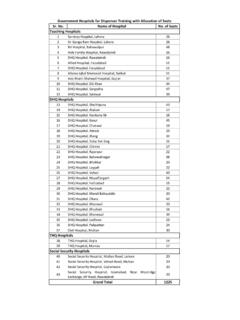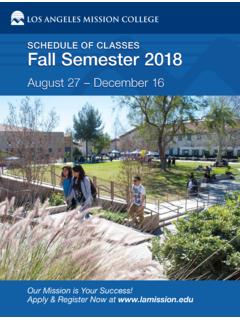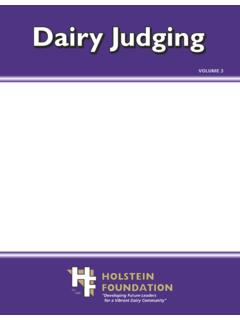Transcription of Diploma in Radiography and Medical Imaging (New Scheme)
1 Curriculum for the Two Years Post Matric Competency Based Diploma in Radiography and Medical Imaging (New Scheme) Punjab Medical Faculty 2013 1 Table of Contents Page Preface 2 General Outline 3 Section I: Basics of Diagnostic Radiology 7 Subsection 1: Radiological Anatomy 8 Subsection II: Physics 10 Unit 1: General Physics 11 Unit 2: Radiation Physics 12 Unit 3: Health Physics 13 Section II: Application of Diagnostic Radiology 14 Subsection 1: Imaging equipment, Accessories; maintenance and Quality Assurance 15 Subsection 2: 17 Unit 1: Radiographic Techniques 17 Unit 2: Radiography Procedures with Contrast 19 Unit 3: Advanced Radiology 21 Practical Attachment: 23 Recommended Reading for Teachers 24 Acknowledgments 25 2 Preface After introduction of the new service structure for Allied Health Professionals (AHPs) in 2012 the qualification requirement for entry in service has been changed to a Diploma of two years duration.
2 This decision has necessitated the development of curricula for the new scheme of studies. The evolving health needs of the community, exponential advances in Medical and allied technologies and changes in health services provision, functions and structure also demand continual and responsive changes in education and training programs meant for AHPs. The revised curricula would carry out the following important functions: link pre-service education and training with actual tasks AHPs have to perform after being employed, especially in the public sector modernize training program by weeding out subjects that have become obsolete and including subjects that are currently considered essential provide clarity on subjects and topics to be taught delimiting the breadth and depth of teaching give clarity to examiners on what is to be tested and how stimulate critical faculties of both teachers and students to conceptualize topics rather than memorizing them.
3 Focus of the new curricula would be on integration of tasks and multi-skilling of students. Thus there would be a common knowledge base for all courses in the form of a Core Course which would provide insight into essential technical knowledge besides providing base for development of the education for Allied Health Sciences up to post graduate level. The new curriculum for Radiology and Medical Imaging Technology replaces and augments the previous curriculum for Radiographers. The goal of this document has been to outline a common body of knowledge that is essential for entry-level Radiography technicians.
4 Combined with the Core Course it will provide a broad knowledge base for the technicians and provide opportunities for practical skill development in the relevant field. This needs based curriculum places practical skills development at high priority. Content and apprenticeship experiences is designed to sequentially develop, apply, critically analyze, integrate, synthesize and evaluate concepts and theories in the performance of radiologic procedures. There will be two papers to assess the knowledge gained and two practical / viva examinations to assess the concepts and skills. The papers are: 1 Basics of Diagnostic Radiology: Radiological Anatomy; General Physics, Radiation Physics & Physics of Diagnostic Radiology; Imaging equipment, Accessories, Maintenance and Quality Assurance 2 Application of Diagnostic Radiology: Radiographic Techniques, Contrast and Special Radiography Procedures, Advanced Radiology 3 General Outline Aim of this curriculum is to equip students with the relevant professional knowledge, skills and techniques to enable them to apply their acquired expertise for efficient health service delivery.
5 At the end of training the student should be able exhibit the following general and specific competencies: A. General learning objectives 1. Act upon his / her job description ethically keeping in mind the requirements of community and people at large. 2. Demonstrate empathy and humane approach towards communities and exhibit interpersonal behavior in accordance with the societal norms and expectations. 3. Demonstrate sufficient understanding of basic sciences related to the technology and be able to integrate such knowledge in his / her work. B. Specific learning objectives: Radiography Technician is in charge of one or more X-Ray units and is responsible for its proper working and maintenance.
6 S/he assists use of X-ray, computerized tomography (CT), angiography, fluoroscopy, ultrasound and magnetic resonance Imaging (MRI) to produce images of organs and body parts. Following competencies will be expected from a student completing a Diploma course in Radiography and Medical Imaging . The student should be able to: Radiography / Technical Use initiative to prioritize, deliver and time-manage workload effectively and, when required assist senior staff to plan efficient control of work flow patterns within the department. Position patients safely for examinations and, adapts standard techniques depending on Medical /surgical conditions associated with disability, illness or trauma.
7 Perform a range of radiographic examinations on patients to produce high-quality images. Assist radiologist and senior staff in complex radiological examinations. Record Imaging identification and patient documentation quickly and accurately and observes protocols. Ensure that the X-Ray films of the patients from wards are sent to the wards as soon as Radiologist has written the report. 4 Preventive Ensure safe custody of all the accessories of the X-Ray unit of which s/he is in charge. Keeps the X-Ray rooms locked when not in use. Understand and observes health and safety precautions/instructions for self and others protection.
8 Wears dosimeter during duty. Ensure that cardiac and respiratory stimulants are at hand, whenever any special investigation with contrast media is being undertaken. General Ensures that the unit is not misused. Confirms that the unit and the room where it is installed are cleaned at the commencement and the termination of work and additionally if required. That daily account of the X-Ray films expended is kept by making entries in the Stock Book and whenever, film packets are taken out of the stores. Learns new techniques and technologies as required by professional bodies. Imparts appropriate training to students and other staff.
9 C. Distribution of Training Time The two years program would be divided in three distinct parts (Papers). There will be a Core Course which would be common for all technologies. The examination for this component will be taken at the end of first academic year. The teaching for specific aspect of this technology will be divided in two sections; examination for these will be held at the end of second academic year however, teaching for specific techniques will start from the first year. A typical training day for students at training institutions routinely comprises of five hours. Keeping a generous allowance of holidays and weekends, an academic year for students would be 200 days.
10 Therefore, 1000 teaching hours would be available in 12 months. In the new scheme of studies, for the Core Course the proportion of classroom teaching and practical training (applied learning activities) would be 60:40; whereas this proportion for the specific techniques would be 40:60 and the time allocations for dividing teaching time between various topics, units and sub-units will be done accordingly as depicted below: Core Course 500 Section I (Paper I) 750 Section II (Paper II) 750 Total 2000 5 The marks distribution for this Diploma would be: Subject Marks First Year Core Course 100 Viva 100 Second Year Section I 100 Section II 100 Practical / Viva Section I 100 Practical / Viva Section II 100 Total: 600 D.










